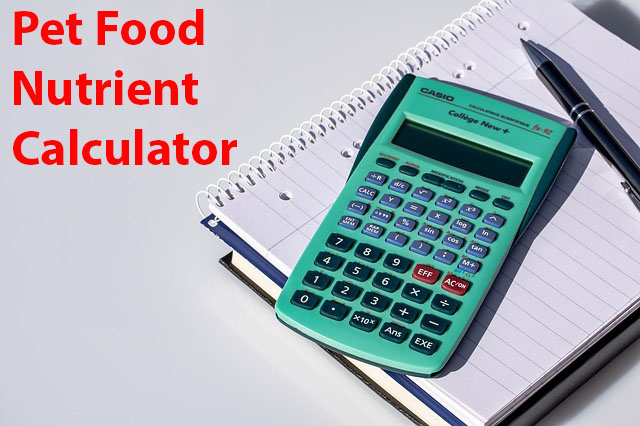Pet Food Nutrient Calculator: Comparing nutrient levels between two pet foods
Many owners use the label to compare the amounts of nutrients in different pet foods. Or they look on the manufacturers’ websites or even give them a call to get more information on nutrient levels. Once you get these numbers, the comparison isn’t as easy as it seems, however. Two things need to be considered about nutrient levels in pet food:
- The numbers you get from the label (and usually the numbers you get from the manufacturer) are usually either in percent, mg/kg, ppm (parts per million), or more rarely IU/kg.
- These nutrient amounts are usually given on an “as fed” basis (i.e. as the food is in the bag or can). “As fed” numbers make it very difficult to compare foods because they don’t take into account the variable levels of water or calories in different foods.
Comparing a nutrient in two dry foods
As an example, think about the two foods in Table 1 below. These are real dry dog foods that both have the same % of calcium as fed. However, they differ dramatically in terms of calories! If your dog requires 500 calories per day to stay at her optimal weight, she’d need to eat 2 cups of Diet A per day or 1 cup of Diet B per day to meet her calorie needs. When we calculate how much calcium she is actually getting from each food, in milligrams (mg), we see that because she’s eating twice as much of Diet A, she’s also getting twice as much calcium from Diet A.
| Calories/cup | % Calcium on label or website | Mg of calcium per cup | Cups eaten per day | Total mg calcium eaten per day | |
| Diet A | 250 | 1.12% | 430 | 2 | 860 |
| Diet B | 500 | 1.12% | 296 | 1 | 296 |
| Table 1. Comparison of the calcium content of two dry dog foods fed to a dog that needs 500 kcal per day to maintain an ideal weight. | |||||
Now let’s look at two cat foods, one dry and one canned (Table 2). Perhaps your vet has suggested trying a lower fat diet for your cat. Which diet do you think is lower in fat – Diet A, a dry food that contains 12% fat, or Diet B, a canned food that contains 6% fat? It seems obvious that it should be the canned food, but as you can see below, once we take the water out (called dry matter) and adjust for the calories, the canned food actually has nearly twice the fat that is in the dry food. This is because the percentages on the label include all the water in the food and don’t take into account the calories in the food, either. The average dry food is about 10% water and canned foods are approximately 75% water. Therefore, the percentages on the canned food will always look much lower compared to dry foods.
| Type of diet | % fat on label | % moisture | % fat dry matter | Fat g/100 kcal food | |
| Diet A | dry | 12 | 7% | 12.8 | 3.5 |
| Diet B | canned | 6 | 78% | 26.3 | 6.3 |
| Table 2. Comparison of the fat content of a dry with a canned cat food | |||||
The best way around these issues is to convert the nutrient amounts to the same units based on calories [units per 100 calories (kcal)] so you can compare apples to apples. This conversion involves some math, but we’ve made it easy for you with this calculator.
To use this calculator, you’ll need 2 pieces of information:
- How many calories are in your food or treat, in kcal/kg. This information should be on the label, but may also be on the manufacturer’s website. If you can’t find it on either of those, you’ll need to call the manufacturer’s customer service line (and you should be suspicious of the manufacturer as this information is required to be on food labels and most treat labels!).
- You’ll also need to know the amounts of the nutrient(s) you are interested in (sodium, fat, copper, phosphorus, etc) on an “as fed” basis – this information may be on the website, but you’ll more likely need to call the customer service line. Ask for the “average” or “typical” analysis (not the “guaranteed analysis,” which is only minimums or maximums). And double check that they’re giving you numbers on an “as fed” basis. Remember, if the company can’t or won’t give you this information, it should be a red flag and you probably don’t want to feed that food to your pet.

